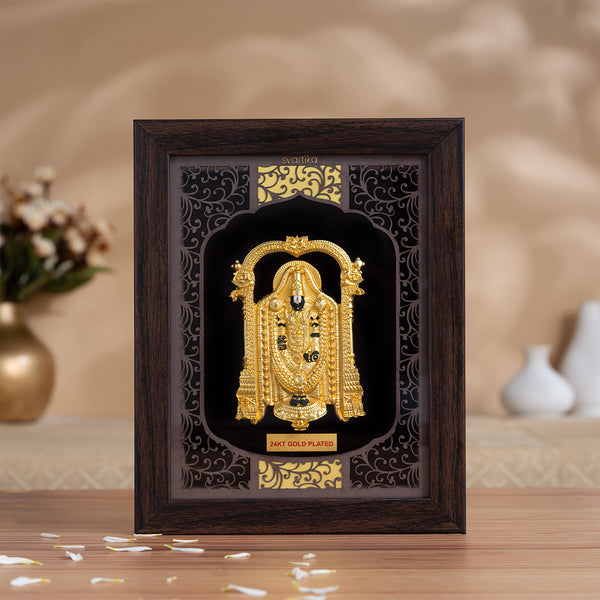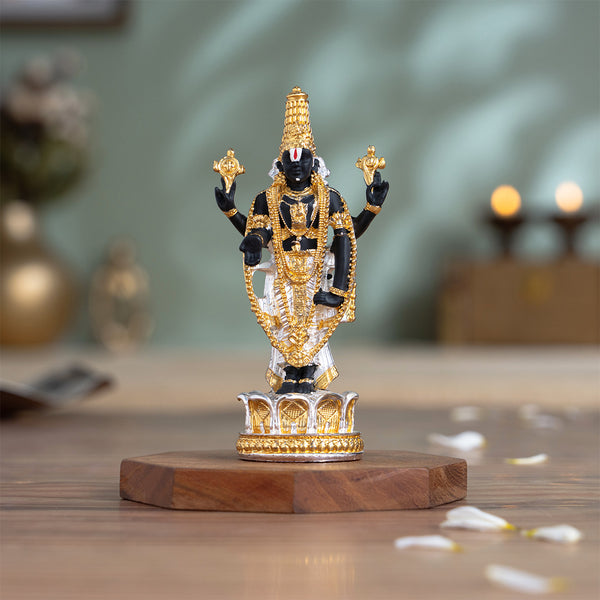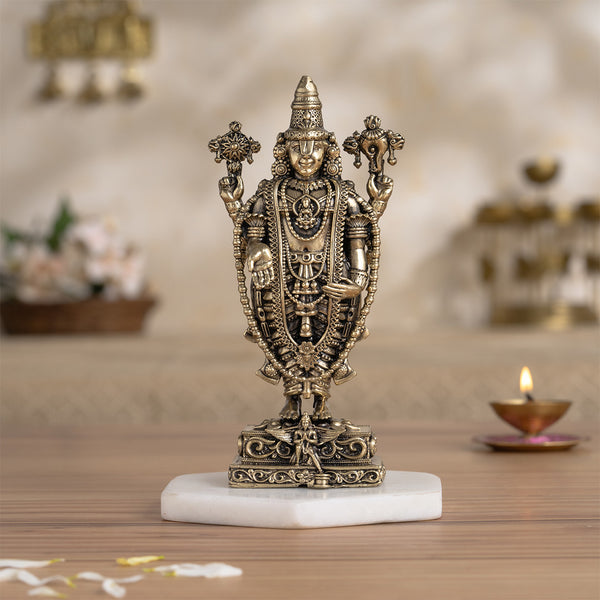The one deity universally known and loved has got to be Lord Balaji!
Who doesn’t include the yatra to Tirupathi as something that they have to do? Millions of people seek the blessings of this Lord and Savior each year.
One of the most-visited places of worship in the history of India, Lord Balaji has carved himself into our hearts and souls forever.
Lord Balaji is a reincarnation of Maha Vishnu.
The Tirumala Venkateswara Temple, known as the richest temple in the world, is located in Tirupati, Sri Balaji District, Andhra Pradesh, India, and is dedicated to Venkateshwara.
Venkateshvara means "Lord of Venkata" in Sanskrit. The word is a compound of Venkata (the name of a hill in Andhra Pradesh) and ishvara (the Sanskrit word for "Lord").
According to the Brahmanda and Bhavishyottara Puranas, the name "Venkata" means "destroyer of sins" because it is derived from the Sanskrit words vem (sins) and kata (power of immunity).
Srinivasa (in whom Lakshmi resides), Narayana (the creator and destroyer), Perumal (the mighty lord), Malaiyappa (the lord of the Hill), and Govinda are only a few of the names by which Venkateshvara is known.
He is worshiped as the god of the seven hills, or "yedu kondala venkanna" in Telugu.

Tirupati Balaji 3D Wall Frame - Gold Plated Finish
The Origin of Tirupati Balaji (Venkateswara)

The much-hailed temple, that remains to be the pride and joy of Hindus, the Tirupati Balaji (or Venkateswara) can trace its history back to ancient Hindu mythology.
The Hindu god Venkateswara is said to have taken human form to aid his devotees in their struggles with the material world.
According to myth, Lord Vishnu once chose to assume human form so that he may experience life as one of his many devoted followers. Prince Venkatachala grew up to be a respected and beloved leader for his people.
A sage by the name of Bhrigu once visited Venkatachala at his palace to put his hospitality to the test.
The prince's wife became enraged and smacked the sage after he kicked him in the chest. Venkatachala asked Bhrigu for forgiveness and expressed regret.
Lord Vishnu, who had been dwelling in Venkatachala's heart, was knocked out of his body by Bhrigu's kick and so decided to abandon the mortal realm.
The Tirupati Balaji temple was built on the site of a little image of him left behind by his followers.
Whose Avatar is Tirupati Balaji?
Shri Vishnu's avatar, Lord Balaji, is revered by Hindus. He is also known as Venkateswara, Tirupati Thimmappa, and Govinda.
Since the liberation of humanity was the ultimate goal of Lord Vishnu, he transformed into a granite stone idol and moved to the holy Seven Hills.
His two wives, Goddess Lakshmi and Princess Padmavati, also had their forms carved into stone so they may always be by his side.
Padmavati Devi rests her head on his left shoulder, while Goddess Lakshmi rests her left arm across his chest.
Tirupati, home to Lord Balaji, attracts millions of worshippers each year. His divine nature, charisma, and mystique all serve to attract believers from all walks of life and regions of the world.
Even if they have to wait all day, devoted followers of the Lord will be granted the privilege of being in his presence if they sincerely pronounce his name.
Located in the town of Tirumala in the Indian state of Andhra Pradesh, the temple holds intriguing secrets and stands as one of the most renowned Hindu pilgrimage sites globally.
It attracts a multitude of visitors seeking spiritual solace and divine blessings.
The temple is believed to possess the power to grant the heartfelt desires of devotees and bring forth abundant good fortune.
By offering prayers, delving into the enigmatic tales of the temple, and making generous donations, worshippers hope to unlock the mystic wonders and receive blessings beyond measure.
History of Tirupati Balaji

The story starts with Rishi Bhrigu, one of the Saptarishis, who was supposed to represent God's richness, thus the Rishis led by Rishl Kashyapa consulted him when they chose to perform a yagna on the banks of the Ganga before the coming of Kaliyuga.
When the sages could not answer Narada's questions regarding why they were performing the yogna and which deity they wanted to praise, they went to Bhrigu.
He visited the temples of Brahma, Shiva, and Vishnu to solicit their advice before devising a remedy. However, neither of the gods paid him any attention.
The sage had already kicked Vishnu in the chest in his wrath.
When Lord Vishnu held the sage's legs and gently squeezed on the extra eye in the sole of Bhigru's foot which was considered to reflect the sage's egotism, the sage acknowledged his error.
The wise man begged mercy. He returned to the other wise men to inform them that Lord Vishnu was worthy of their adoration. However, Goddess Lakshmi was insulted by the behavior of Rishi Bhrigu and left.
Lord Vishnu was devastated when Lakshmi left. When he didn't see his wife, he began fasting and meditating.
Concerned about the situation, the Gods Brahma and Shiva disguised themselves as cow and calf.
Surya, the Hindu sun deity, begged the goddess Lakshmi to take the appearance of a cowherd so that he may acquire her services from the Chola ruler.
In the Venkata mountains, the King's new herd of cows can be seen grazing. Lord Brahma, disguised as a cow, began feeding Vishnu on the anthill.
The Queen was irritated because she wasn't getting any milk from the cow and she reprimanded the cow herder. He was perplexed to see the cow defecate across the anthill.
In a fit of rage, he grabbed an axe and attempted to butcher the cow.
Lord Vishnu, appearing from the anthill, took the strike in place of the cow, sparing its life.
Lord Vishnu, infuriated, pronounced a death curse on the shepherd. He used the axe that killed an innocent cow and calf that gave him water as he bled to death.
Because of the servant's transgression, Lord Vishnu cursed the king to take on the form of an Asura. The benevolent god begged the king to forgive him, then told him that in his next life, he would be reincarnated as Akash Raja and marry his daughter.
Lord Vishnu assumed the identity of Srinivasa in his subsequent incarnation and was born to a woman named Vakula Devi.
Lord Krishna supposedly granted Yashoda the wish to have him born to her in the Kali Yuga as a blessing. It is believed that Vakula Devi is Yashoda's reincarnation. Srinivasa's previous home was in the woods.
Padmavati, daughter of Akash Raja, was a stunning woman whom Lord Srinivasa eventually met.In keeping with the promise made by Lord Vishnu to the previous incarnation's Chola king, the two soon fell in love and wanted to get married.
Srinivasa borrowed money from Kubera for his wedding and promised to pay back the debt with interest until the end of the Kali Yuga.
Sage Narada informed Lakshmi of the wedding after it was over.
The Gods and Goddesses were furious and confronted Vishnu. Srinivasa's decision to become a stone was motivated by tensions between his two wives.
It is also said that Padmavati and Lakshmi, who stood on either side of Vakula Devi, turned into stone.
Significance of Tirupati Balaji

Lord Balaji is accepted as the God of Justice.
It is believed that the two wives laying on his chest represent the scales of justice and the sword of justice, while the Namam on his brow signifies his blindfold. His black appearance is meant to represent Shani, also known as Saturn.
It is believed that the deity evaluates the good and bad actions of those who pray to him. He is well-known for his ability to both reward and punish.
Devotion, love, and faith in the Lord bring forth his mercy, which mitigates the damage done by one's previous conduct.
Festivals Dedicated to Lord Balaji

The Venkateswara Temple in Tirumala-Tirupati, Tirupati district, Andhra Pradesh, India, hosts the most important yearly festival, known as Sri Venkateswara Swami vari Brahmotsavam or Srivari Brahmotsavam.
The celebration lasts for a full month during the Hindu month of vina, which occurs between September and October in the Gregorian calendar.
Many vahanams (vehicles) are used to carry the Utsava-murti (processional deity) of the temple's presiding deity, Venkateswara, and his consorts Sridevi and Bhudevi, through the streets outside the temple.
Visitors and devotees come from all over India and the world to attend the festival, and Tirumala offers a plethora of places to visit in Tirumala.
One of the most prominent events is the grand Brahmotsavam, a purification festival held in honor of Lord Brahma.
Apart from the divine festivities, Tirumala boasts several captivating attractions for pilgrims and tourists alike.
From the sacred Sri Venkateswara Swamy Temple to the serene Akasa Ganga waterfall, there are numerous enchanting spots waiting to be explored.
Immerse yourself in the spiritual ambiance while also taking in the natural beauty and cultural heritage that Tirumala has to offer.
Final Reflection
For Hindus all across the world, the Tirumala temple is a center of worship and devotion. It is widely held that Tirupati Balaji is actually a reincarnation of Vishnu.
As a result, millions of Hindus around the world worship him as a divinity in their religion.
Tirupati Balaji is worshipped at the Tirumala temple, which is thought to have been constructed more than two thousand years ago. The temple is a well-known landmark and an excellent example of Dravidian design.
Millions of worshippers visit this temple annually for the Brahmotsavam festival, one of the most important rites and rituals.
Tirupati Balaji is widely revered as a major Hindu deity, and his temple holds tremendous religious and cultural weight.

Tirupati Balaji (Venkateswara) Idol - Gold & Silver Plated

Brass Tirupati Balaji Idol (Venkateshwara) with Garuda Base (6 Inch)
Frequently Asked Questions
1. Who is Lord Balaji's wife?
It is widely held that Lord Balaji (also known as Lord Venkateswara) weds Goddess Padmavati (also known as Alamelumanga) in Hindu mythology.
Temples dedicated to Lord Venkateswara hold festivals and rituals to honour the union of Lord Balaji and Goddess Padmavati.
Their union is the subject of a well-known Hindu myth connected to India's well-known Tirumala Venkateswara Temple in the state of Andhra Pradesh.
2. Who is the son of Tirupati Balaji?
Lord Venkateswara, also known as Tirupati Balaji, is revered as a manifestation of Vishnu, one of the most important deities in Hinduism.
Goddess Lakshmi and Goddess Padmavati or Alamelumanga are two of Lord Vishnu's wives in Hindu mythology.
Lord Venkateswara (or Srinivasa) is a Hindu deity worshipped as the reincarnation of Vishnu and Padmavati (or Alamelumanga).
In Hindu mythology, Lord Venkateswara, also known as Tirupati Balaji, is revered as the fountainhead of good fortune, joy, and bliss, although he is not thought to have a son.
3. Which is Balaji God Day?
Fridays and Saturdays are usually considered to be auspicious for Lord Vishnu.
4. Is Balaji Krishna or Hanuman?
Lord Hanuman is known as Balaji Hanuman in certain parts of India. These days, most people who pray to the god Venkateswara at the Tirumala Tirupati Temple would refer to him as Balaji.
The difficult and tiring wait is forgotten the moment devotees catch sight of the stunning idol placed in the holiest of holies.
Even if the devotees only get a few seconds of Darshan due to the large crowd, they consider themselves fortunate to have the opportunity.







